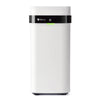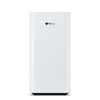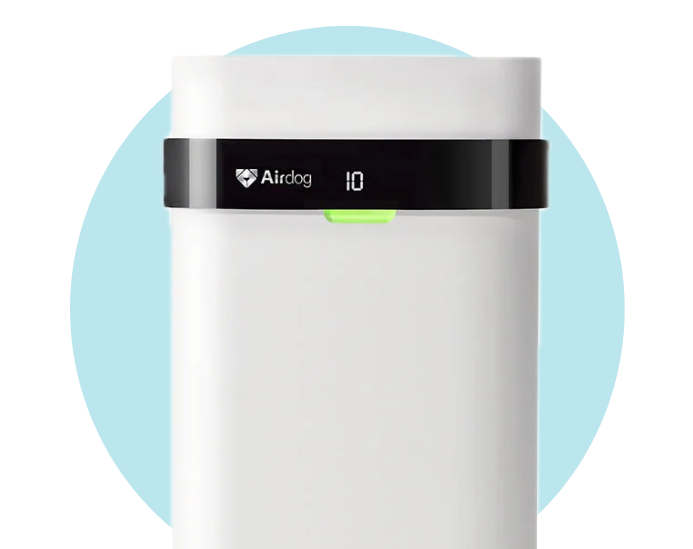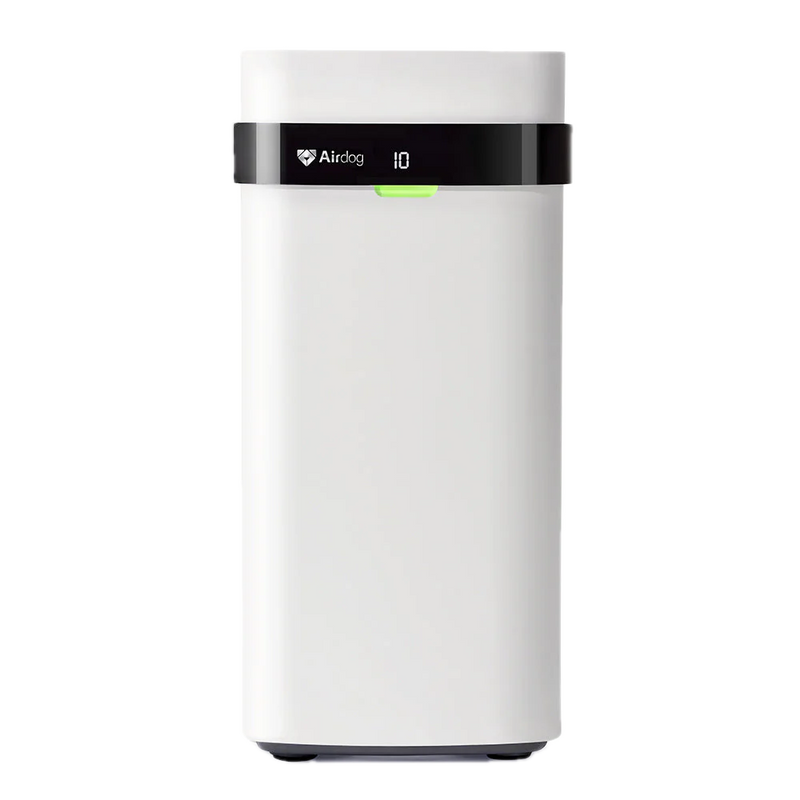Did you know that more than 50% of households in the United States have pets? These furry friends bring joy, companionship, and unconditional love. But, for many, they also bring a less welcome companion: pet allergies. It's a challenge that a significant portion of the population faces, trying to balance their love for their pets with the discomfort of allergic reactions. This dilemma often leads to the question: Do air purifiers help with pet allergies?
This article explores how air purifiers can offer a much-needed solution, delving into the science behind pet allergies and the effectiveness of air filtration.
The Science Behind Air Purifiers and Pet Allergies
Understanding Airdog’s Technology
At the core of Airdog’s advanced air purifiers is a combination of innovative filtration systems designed to tackle allergens and improve indoor air quality. These technologies are built to effectively capture and remove particles like pet dander, one of the primary triggers for pet allergies. Airdog's air purifiers use a multi-stage filtration approach that includes a combination of electrostatic and activated carbon technologies, which work together to filter out microscopic particles and odors.
-
Particle Size Capture: Airdog’s electrostatic filters excel at capturing particles in the size range of pet dander, ensuring that allergens are effectively removed from the air. The electrostatic process attracts and traps particles as small as 0.0146 microns, providing high-efficiency filtration.
-
Filter Composition: Airdog’s filters use a unique electrostatic technology that enhances the ability to capture allergens and particles, combined with layers designed to effectively trap both particulates and gases. This advanced technology prevents allergens from circulating back into your home environment.
The Role of Activated Carbon Filters
In addition to pet dander, pet odors can also be a concern for pet owners. Airdog incorporates activated carbon filters, which are specifically designed to tackle these odors. Activated carbon works through adsorption, where the carbon material traps odor molecules within its pores, effectively eliminating pet odors from the air.
-
Odor Elimination: Activated carbon filters are highly effective at removing pet odors, as well as other household smells, by trapping odor-causing molecules.
-
Complementary Technology: Used in conjunction with other filtration technologies, activated carbon filters enhance the overall air purification process by addressing both particulate and gaseous pollutants.
Importance of Air Purifier Placement and Maintenance
To maximize the benefits of air purifiers in managing pet allergies, the placement and maintenance of these devices are crucial aspects to consider.
-
Strategic Placement: Optimal placement near pet areas, such as sleeping quarters or play areas, can significantly improve the capture of pet dander and odors. However, ensuring the air purifier does not become obstructed by furniture or walls is equally important for effective air circulation.
-
Regular Maintenance: The efficacy of air purifiers depends on regular maintenance, including filter cleaning according to the manufacturer's guidelines. A well-maintained air purifier continues to perform at its best, ensuring allergens and odors are consistently removed from the indoor air.
By understanding the technology behind Airdog’s technology and the added benefit of filtration technologies, pet owners can make informed decisions about selecting and maintaining air purifiers.
Evaluating the Effectiveness of Air Purifiers in Allergy Management
Insights from Scientific Studies
The relationship between air purifiers and pet allergy symptom relief has been the subject of scientific scrutiny. Two pivotal studies, conducted in 1999 and 2011, offer valuable insights into how air filtration technology impacts the presence of airborne dog allergens and allergic symptoms in individuals.
-
1999 Study on Airborne Dog Allergen: This study revealed that the use of air cleaners significantly reduced the levels of airborne Can f 1, a common dog allergen, in homes with dogs. The implication for pet owners is profound, suggesting that air purifiers equipped with filtration technology can play a critical role in reducing exposure to pet allergens.
-
2011 Study on Air Filters and Allergic Symptoms: The latter study further supports the effectiveness of air purifiers, reporting an average reduction of 26% in morning symptoms and 24% in evening symptoms among participants. These findings underscore the potential of air purifiers to alleviate the discomfort associated with pet allergies, offering a tangible improvement in the quality of life for sufferers.
Significance for Pet Owners
For pet owners grappling with allergies, these studies give hope. The ability of air purifiers to significantly decrease allergen levels in the home environment means that individuals can enjoy the companionship of their pets without suffering the full brunt of allergy symptoms.
-
Improved Indoor Air Quality: The reduction of allergens contributes to an overall improvement in indoor air quality, making the home environment more comfortable and healthier for all occupants, not just allergy sufferers.
-
Enhanced Comfort and Well-being: By mitigating allergic symptoms, air purifiers can enhance the overall comfort and well-being of pet owners, enabling them to engage more freely and comfortably with their pets.
Potential Limitations
Despite the promising results, relying solely on air purifiers for allergy relief comes with potential limitations. It is essential for pet owners to have realistic expectations regarding the scope of relief air purifiers can provide.
-
Not a Standalone Solution: Air purifiers are most effective when used in conjunction with other allergy management strategies, such as regular pet grooming, thorough house cleaning, and the use of allergen-resistant bedding.
-
Maintenance and Placement: The effectiveness of air purifiers is contingent upon proper maintenance and strategic placement within the home. Filters require regular replacement, and devices must be placed in areas where pets spend most of their time to maximize allergen capture.
-
Individual Variability: The degree of symptom relief can vary widely among individuals. Factors such as the severity of allergies, the type of pet, and the home environment can influence the effectiveness of air purifiers in allergy management.
In light of these studies, it becomes clear that air purifiers represent a valuable tool in the arsenal against pet allergies. They offer a means to significantly reduce allergen levels in the home and alleviate symptoms for many individuals. However, for optimal results, they should be part of a comprehensive approach to allergy management that includes both environmental and personal health strategies.
Choosing the Right Air Purifier for Pet Allergies
Navigating the myriad options for air purifiers to find the right one for managing pet allergies can seem daunting. However, leveraging expert recommendations and understanding key features can simplify the process.
The Importance of CADR Ratings
CADR (Clean Air Delivery Rate) ratings are a close second in importance, providing a standardized measurement of the purifier's effectiveness in filtering specific pollutants, including pet dander, smoke, and pollen.
-
Higher Ratings: A higher CADR rating indicates a more efficient air purifier, capable of filtering larger volumes of air within a given time frame, thus offering faster relief from pet allergens.
-
Selection Criterion: Selecting a purifier with a high CADR rating ensures more effective and rapid removal of pet dander from your indoor environment.
Maintenance and Additional Strategies for Managing Pet Allergies
Beyond merely purchasing an air purifier, managing pet allergies requires a comprehensive strategy that encompasses regular maintenance of air purifiers and other proactive measures. Incorporating advice from the Cleveland Clinic on treatment options and emphasizing the significance of upkeep, this section delves into a holistic approach for allergy management.
Air Purifier Maintenance
Maintaining an air purifier extends beyond simple operation, ensuring the device operates at peak efficiency for capturing pet dander and other allergens.
-
Filter Cleaning: Unlike traditional filters that require regular replacement, Airdog’s filters are washable, which makes maintenance more cost-effective and convenient. To maintain peak performance, it’s important to clean the filters every 1-3 months, depending on usage. Simply remove the filter, rinse it under water, and let it dry completely before reattaching it. This will ensure that the filters continue to trap allergens efficiently without losing their effectiveness.
-
Cleaning External Components: Dust and debris can accumulate on the exterior vents and internal components of the air purifier. Regularly wiping these parts down with a damp cloth maintains airflow and purifier efficiency.
Comprehensive Pet Allergy Management
Addressing pet allergies involves more than air purification. Implementing additional strategies can minimize allergen exposure and enhance overall indoor air quality.
Frequent Pet Grooming
-
Regular Baths: Washing pets weekly can significantly reduce the amount of dander they shed into the environment. Using hypoallergenic pet shampoo can also help.
-
Brushing: Daily brushing, ideally outdoors, removes loose fur and dander, preventing it from becoming airborne or settling on surfaces indoors.
House Cleaning Tips
-
Dust and Vacuum Regularly: Using a vacuum with a HEPA filter on carpets and upholstery at least twice a week reduces allergen accumulation. Dusting with a damp cloth prevents allergens from being stirred into the air.
-
Minimize Textiles: Carpets, drapes, and upholstered furniture can trap pet dander. Opting for hardwood floors, blinds, and leather furniture can reduce surfaces where allergens can accumulate.
Allergen-Resistant Bedding
-
Encasements: Using allergen-proof covers for mattresses, pillows, and comforters create a barrier that prevents dander from penetrating bedding.
-
Wash Bedding Frequently: Washing sheets, pillowcases, and pet bedding in hot water weekly eliminates dander and other allergens that accumulate on fabric surfaces.
Additional Allergy Treatment Options
Beyond environmental controls, pursuing medical advice for allergy treatment can provide relief.
-
Antihistamines and Decongestants: Over-the-counter options can relieve symptoms, but consulting with a healthcare provider can tailor treatments to individual needs.
-
Immunotherapy: In some cases, allergy shots or sublingual immunotherapy (SLIT) offer long-term relief by gradually desensitizing the immune system to pet allergens.
Regular upkeep of air purification systems, coupled with frequent pet grooming, strategic house cleaning, and the use of allergen-resistant bedding, can significantly reduce pet allergen levels in the home. For those whose pet allergy symptoms persist, consulting healthcare providers for tailored treatment options can offer further relief, ensuring a comfortable coexistence with beloved pets.
Conclusion
Managing pet allergies can be a challenging but manageable task for pet owners. Air purifiers, especially those equipped with advanced filtration technologies and activated carbon filters, play a crucial role in reducing the presence of pet dander and odors in the home. By using advanced technologies, such as Airdog’s multi-stage filtration systems, pet owners can significantly improve indoor air quality and alleviate allergy symptoms. However, for optimal results, air purifiers should be part of a holistic approach that includes regular maintenance of the purifier, consistent pet grooming, thorough house cleaning, and potentially medical treatments.





